5. List
1. 列表结构
利用 中括号
列表内的元素用 逗号 隔开
注意是 英文输入法 下的逗号
student1 = ['lilei', 18, 'class01', 201901]
student2 = ['hanmeimei', 19, 'class02', 201902]
列表的 可变性 :可以修改列表内的内容。
- 字符串强制转换成列表
string_to_list = list('Bornforthis')
print(string_to_list)
# output
['B', 'o', 'r', 'n', 'f', 'o', 'r', 't', 'h', 'i', 's']
2. 获取列表中的某个元素
2.1 列表下标的组成
2.1.1获取列表中的某个元素
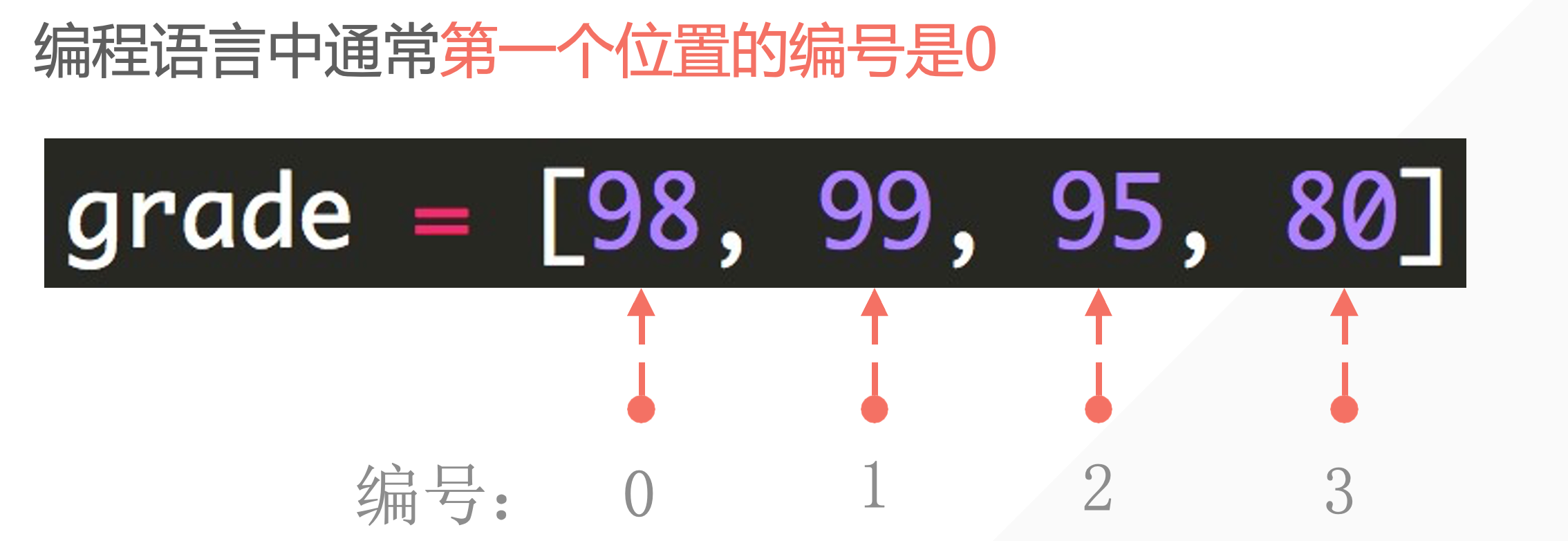
中括号内指定元素位置
grade = [98, 99, 95, 80]
print(grade[0])
print(grade[0] + grade[3])
# output
98
178
2.1.2 获取列表中连续的几个元素
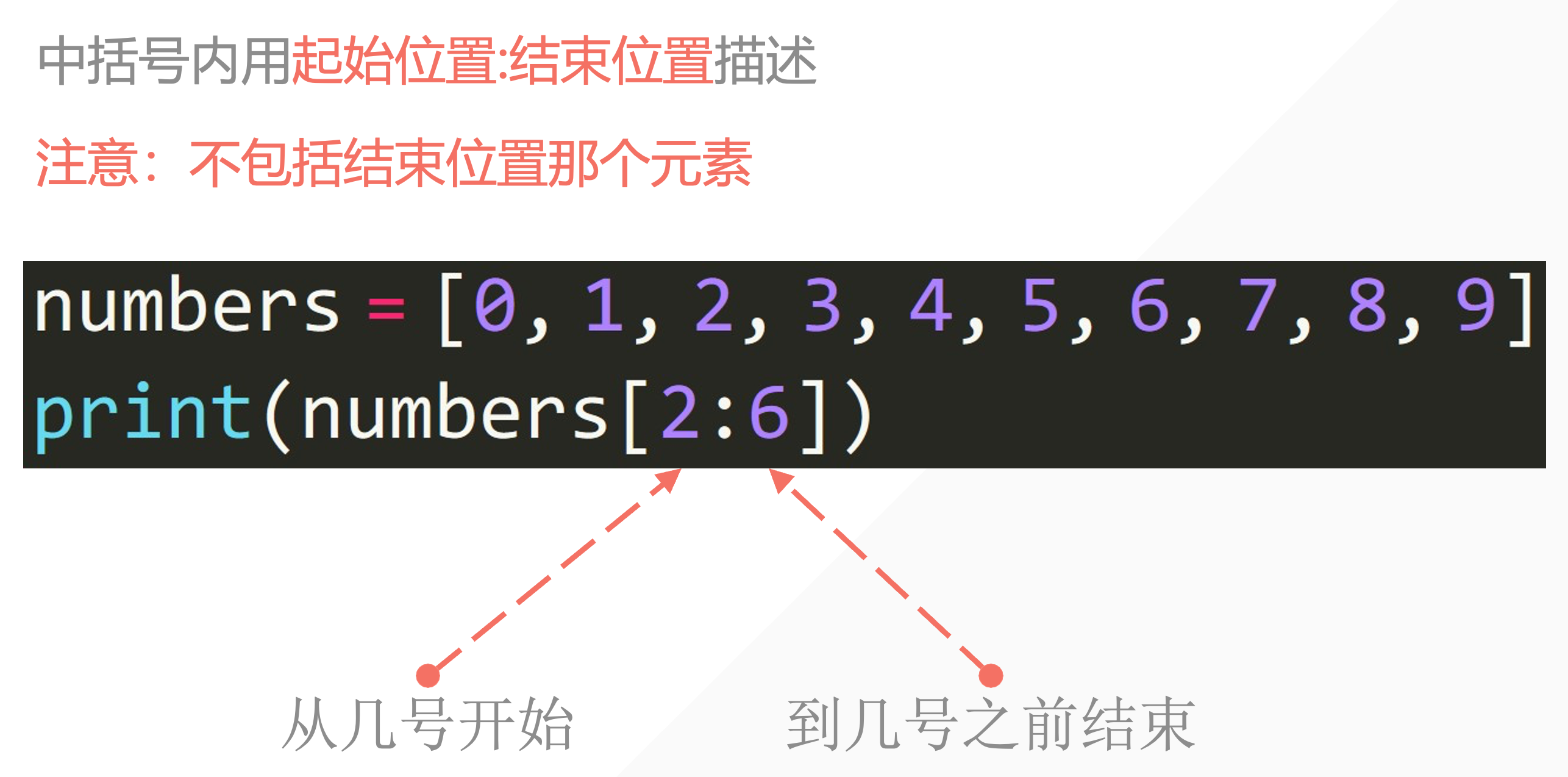
numbers = [0, 1, 2, 3, 4, 5, 6, 7, 8, 9]
print(numbers[2:6])
# output
[2, 3, 4, 5]
2.1.3 **获取**列表中连续的几个元素
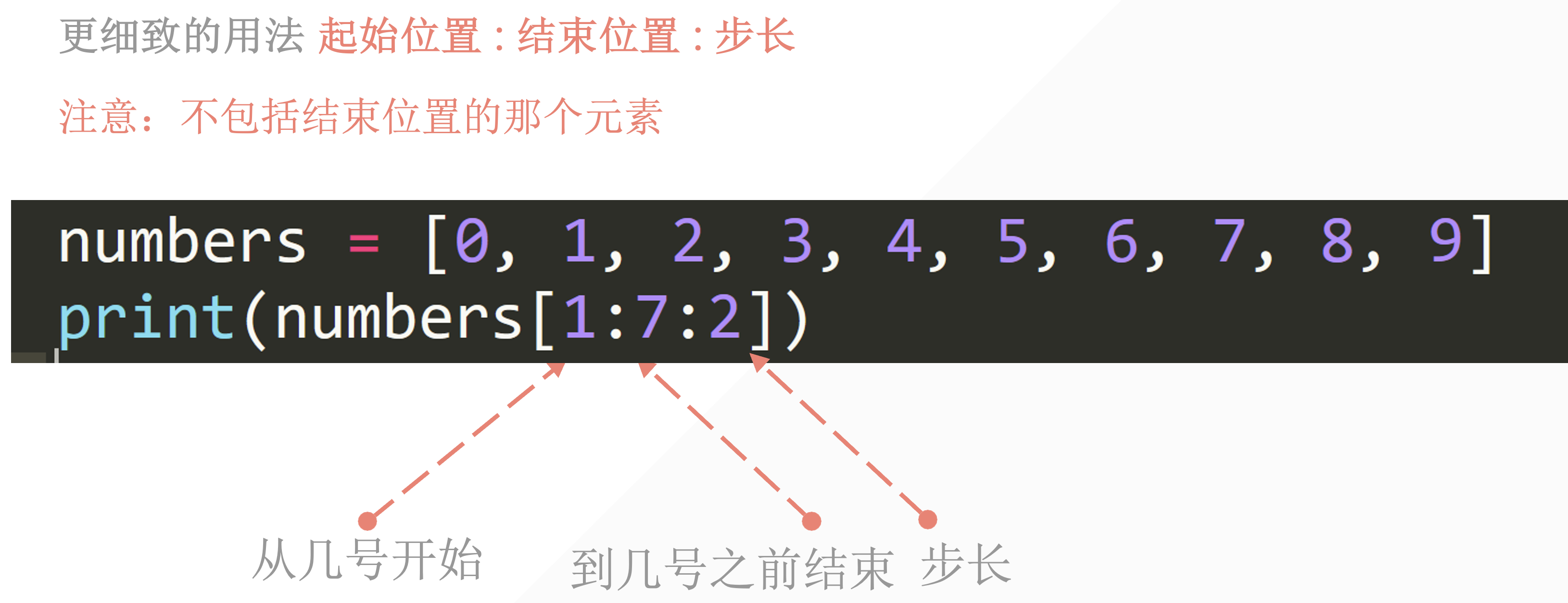
numbers = [0, 1, 2, 3, 4, 5, 6, 7, 8, 9]
print(numbers[1:7:2])
# output
[1, 3, 5]
2.1.4 列表的 切片赋值
In [1]: name = list('Python')
In [2]: name
Out[2]: ['P', 'y', 't', 'h', 'o', 'n']
In [3]: name[2:] = list('abc')
In [4]: name
Out[4]: ['P', 'y', 'a', 'b', 'c']
In [5]: numbers = [1, 5]
In [6]: numbers[1:1]
Out[6]: []
In [7]: numbers[1:1] = [2, 3, 4]
In [8]: numbers
Out[8]: [1, 2, 3, 4, 5]
In [9]: numbers[1:4]
Out[9]: [2, 3, 4]
In [10]: numbers[1:4] = []
In [11]: numbers
Out[11]: [1, 5]
2.1.5 小试牛刀
获取用户输入两个值,一个是要插入的位置,一个是要插入这个位置的值。
- 给定下面列表
numbers = [1, 2, 3, 4, 5, 6]
- 例子
Enter position: 3
Enter value: 4
[1, 2, 3, 4, 5, 6]
- 代码
numbers = [1, 2, 3, 5, 6]
p = int(input("Enter position:"))
v = int(input("Enter Value:"))
numbers[p:p] = [v]
print(numbers)
# output
Enter position: 3
Enter Value: 4
[1, 2, 3, 4, 5, 6]
2.1.6 在列表的特定位置插入元素(.insert(index, element))
.insert(index, element)是一个列表的基本表现方法,用于在列表的指定位置插入一个元素。
他的基本语法是:
list.insert(index, element)
index:指定要插入元素的位置。索引从 0 开始。如果指定的索引超出了列表的当前长度「不会报错」,则元素将被添加到列表的末尾。element:这是你想要插入列表的元素。
numbers = [1, 2, 3, 5, 6]
numbers.insert(3, 4)
print(numbers) # [1, 2, 3, 4, 5, 6]
# output
# [1, 2, 3, 4, 5, 6]
2.1.7 获取列表长度(len())
使用 len()函数返回列表中元素的个数
# 获取列表长度,使用 len():
student_list = ['李雷', '韩梅梅', '马冬梅']
print(len(student_list))
# output
3
2.1.8 修改列表单个元素
通过列表位置编号修改想要修改的元素(list[位置编号])
# 修改列表元素
name = ['lilei', 'hanmeimei']
name[0] = 'madongmei'
print(name)
# output
['madongmei', 'hanmeimei']
2.1.9 修改列表多个元素
类似于前面的切片————list[start:end],在中括号内起始和结束位置(中括号内左闭右开,因此右边位置得多往边缘方向挪动一位)
# 多个元素修改
numbers = [0, 1, 2, 3, 4, 5, 6, 7, 8, 9, 0]
print('before:', numbers)
numbers[1:5] = ['one', 'two', 'three', 'four']
print('after:', numbers)
# output
before: [0, 1, 2, 3, 4, 5, 6, 7, 8, 9, 0]
after: [0, 'one', 'two', 'three', 'four', 5, 6, 7, 8, 9, 0]
字符串也可以被直接分割为元素,加入列表中
# 多个修改的对象也可以是字符串
numbers = [0, 1, 2, 3, 4, 5, 6, 7, 8, 9, 10]
print('before:', numbers)
# 元素数量不一样 & 字符串自动拆开成列表
numbers[1:5] = 'bornforthis'
print('after:', numbers)
# output
before: [0, 1, 2, 3, 4, 5, 6, 7, 8, 9, 10]
after: [0, 'b', 'o', 'r', 'n', 'f', 'o', 'r', 't', 'h', 'i', 's', 5, 6, 7, 8, 9, 10]
注意一点的是:即使选择的位置长度小于塞入的元素,最终也会将所有新元素塞入列表
总结
下面为可以塞入列表的类型
- 列表
- 元组
- 集合
- 字符串
- 字典(放进去的是key)
注意
布尔型 不可以作为列表元素的修改
numbers = [0, 1, 2, 3, 4, 5, 6, 7, 8, 9, 10]
print('before:', numbers)
numbers[1:5] = True
print('after:', numbers)
# output
Traceback (most recent call last):
File "C:\Users\Administrator\PycharmProjects\Coder\Python\code5.py", line 112, in <module>
numbers[1:5] = True
TypeError: can only assign an iterable
2.1.10 向列表末尾添加单个元素 (.append())

# 添加单个元素
lst = ['钥匙', '毒药']
print('before:', lst)
lst.append('解药')
print('after:', lst)
# output
after: ['钥匙', '毒药', '解药']
2.1.11列表末尾添加多个元素(.extend())
# 添加多个元素
inventory = ['钥匙', '毒药', '解药']
inventory.extend(['迷药', '感冒药'])
print(inventory)
# output
['钥匙', '毒药', '解药', '迷药', '感冒药']
2.1.12 删除列表中的元素1(del)
# 删除列表中的元素
# del
# del 需要指定列表中要删除的单个元素或者多个元素,如果不指定元素,则会删除整个列表
student_list = ['李雷', '韩梅梅', '马冬梅']
del student_list[0]
print(student_list)
# output
['韩梅梅', '马冬梅']
student_list = ['李雷', '韩梅梅', '马冬梅']
del student_list # 不指定元素
print(student_list)
# output
Traceback (most recent call last):
File "C:\Users\Administrator\PycharmProjects\Coder\Python\code5.py", line 151, in <module>
print(student_list)
NameError: name 'student_list' is not defined
2.1.13列表指定元素位置删除元素2(.pop())
# 删除列表中的元素
# pop()
# pop() 函数默认删除列表中的最后一个元素
# 也可以传参数指定要删除元素下标。
student_list = ['lilei', 'hanmeimei', 'madongmei']
student_list.pop() # 默认删除最后一个
print(student_list)
student_list = ['lilei', 'hanmeimei', 'madongmei']
student_list.pop(0) # 删除 student_list 的 0 号位
print(student_list)
# output
['lilei', 'hanmeimei']
['hanmeimei', 'madongmei']
2.1.14 列表指定指定元素值删除元素(.remove())
# 删除列表中的元素
# remove()
# remove() 指定列表中某个元素
# 例如:remove('aiyc')
# 则指定删除列表中的 'aiyc' 元素
student_list = ['李雷', '韩梅梅', '马冬梅']
student_list.remove('韩梅梅')
print(student_list)
# output
['李雷', '马冬梅']
2.1.15 两个列表相加(+)
# 两个列表相加
# 直接使用加相加就可以
numbers1 = [0, 1, 2, 3, 4]
numbers2 = [5, 6, 7, 8, 9]
print(numbers1 + numbers2)
# output
[0, 1, 2, 3, 4, 5, 6, 7, 8, 9]
2.1.16 判断元素是否在列表中(in)
# 判断某个元素是否在列表中
inventory = ['a', 'b', 'c']
print('a' in inventory)
print('A' in inventory)
# output
True
False
2.1.17 获取列表中某一元素重复次数(.count())
# 获取列表中某个元素重复的次数(.count())
numbers = [0, 1, 1, 2, 3, 4, 1]
print(numbers.count(1))
# output
3
2.1.18 获取列表中某一元素首次出现的位置(.index())
# 获取列表中某个元素第一次出现的位置(.index())
# 用 list.index(value) 来获取,如果元素不存在则会报错。
numbers = [0, 1, 1, 2, 3, 4, 1]
print(numbers.index(1)) # 1
# output
1
2.1.19 列表排序(.sort())
# 列表排序
# sort(reverse = False)
# list.sort() 使列表内的元素从小到大排列
# 直接修改列表本身
# 如果里面指定 reverse = True 则列表降序排列
numbers = [2, 1, 4, 3, 7, 6, 5, 0, 9, 8]
numbers.sort()
print(numbers) # [0, 1, 2, 3, 4, 5, 6, 7, 8, 9]
numbers = [2, 1, 4, 3, 7, 6, 5, 0, 9, 8]
numbers.sort(reverse = True)
print(numbers) # [9, 8, 7, 6, 5, 4, 3, 2, 1, 0]
# output
[0, 1, 2, 3, 4, 5, 6, 7, 8, 9]
[9, 8, 7, 6, 5, 4, 3, 2, 1, 0]
小试牛刀
将一串字符串 '132569874' 转换成列表并将其输出; 对其中偶数下标的元素进行降序排列,奇数下标的元素不变。
# 将一串字符串 '132569874' 转换成列表并将其输出;
# 对其中偶数下标的元素进行降序排列,奇数下标的元素不变。
list0 = []
list0[:] = '132569874' # 将字符串转换成列表
list1 = list0[1::2] # 选出偶数下标的元素
list1.sort(reverse = True) # 降序排列偶数位置元素
list0[1::2]= list1 # 将原始列表的偶数位置元素从新由排序后的元素覆盖
print(list0)
# output
['1', '3', '2', '5', '6', '9', '8', '7', '4']
['9', '7', '5', '3']
['1', '9', '2', '7', '6', '5', '8', '3', '4']
2.1.20 创建将原列表排序后的新列表(.sorted())
# sorted(list, reverse=False)
# sorted(list, reverse=False) 将列表进行小到大排序,排序后原列表不变,返回新列表。reverse 默认 False,如果设置为 True 则返回降序排序。
lst = [9 ,8 ,10, 7, 6, 5, 4, 3, 2, 1, 0]
new_lst = sorted(lst)
print(new_lst)
lst = [9, 8, 10, 7, 6, 5, 4 ,3 ,2 ,1, 0]
new_lst = sorted(lst, reverse = True)
print(new_lst)
# output
[0, 1, 2, 3, 4, 5, 6, 7, 8, 9, 10]
[10, 9, 8, 7, 6, 5, 4, 3, 2, 1, 0]
2.1.21 反转列表(.reverse())
lst = ['a', 'b', 'c']
lst.reverse()
print(lst)
# output
['c', 'b', 'a']
2.2 列表的深浅拷贝
# 列表的深浅拷贝
# 所存在的问题
x = ['a', 'b', 'c']
y = x
print(f'Orginal:\n\tx: {x}\n\ty: {y}\n\tid_x: {id(x)}\n\tid_y: {id(y)}') # id()用来获取变量的物理地址
y[0] = 'd'
print(f'After:\n\tx: {x}\n\ty: {y}\n\tid_x: {id(x)}\n\tid_y: {id(y)}')
# output
Orginal:
x: ['a', 'b', 'c']
y: ['a', 'b', 'c']
id_x: 2003107131776
id_y: 2003107131776
After:
x: ['d', 'b', 'c']
y: ['d', 'b', 'c']
id_x: 2003107131776
id_y: 2003107131776
发现问题:两者并不独立,修改 y 列表,但是会同时影响 x 列表。为什么会产生这个问题呢?
是因为,在进行y=x的赋值时,只是进行了列表地址的赋值,x、y 实际上指向的是同一个列表。
证明一:Python id 用来检查变量物理地址(也就是在计算机中所在的位置)从上面证明的代码结果可知:x、y 指向的是同一个列表,因为 id 相同。
证明二: 可以直接使用 可视化 查看
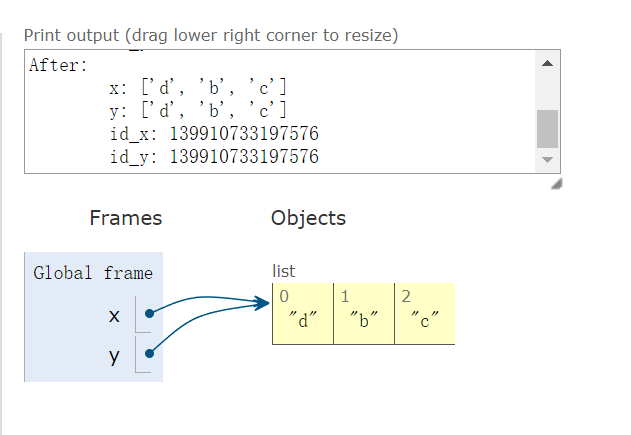
所以改如何解决?————使用copy()进行浅拷贝
2.2.1 浅拷贝 copy()
x = ['a', 'b', 'c']
y = x.copy()
print(f'Orginal:\n\tx: {x}\n\ty: {y}\n\tid_x: {id(x)}\n\tid_y: {id(y)}') # id()用来获取变量的物理地址
y[0] = 'd'
print(f'After:\n\tx: {x}\n\ty: {y}\n\tid_x: {id(x)}\n\tid_y: {id(y)}')
# output
Orginal:
x: ['a', 'b', 'c']
y: ['a', 'b', 'c']
id_x: 2347164512640
id_y: 2347164512896
After:
x: ['a', 'b', 'c']
y: ['d', 'b', 'c']
id_x: 2347164512640
id_y: 2347164512896
那 copy() 会不会存在使用上的一些bug呢?
x = ['a', 'b', 'c', [1, 2, 3]]
y = x.copy()
print(f'Original:\n\tx: {x}\n\ty: {y}\n\tid:\n\t\tid_x: {id(x)}\n\t\tid_y: {id(y)}\n\t\tid_children x[3]: {id(x[3])}\n\t\tid_children y[3]: {id(y[3])}') # id 用来获取变量的物理地址
y[0] = 'd'
print(f'After 1:\n\tx: {x}\n\ty: {y}\n\tid:\n\t\tid_x: {id(x)}\n\t\tid_y: {id(y)}\n\t\tid_children x[3]: {id(x[3])}\n\t\tid_children y[3]: {id(y[3])}')
y[3][0] = 4
print(f'After 2:\n\tx: {x}\n\ty: {y}\n\tid:\n\t\tid_x: {id(x)}\n\t\tid_y: {id(y)}\n\t\tid_children x[3]: {id(x[3])}\n\t\tid_children y[3]: {id(y[3])}')
# output
Original:
x: ['a', 'b', 'c', [1, 2, 3]]
y: ['a', 'b', 'c', [1, 2, 3]]
id:
id_x: 2328236470912
id_y: 2328236752128
id_children x[3]: 2328236470656
id_children y[3]: 2328236470656
After 1:
x: ['a', 'b', 'c', [1, 2, 3]]
y: ['d', 'b', 'c', [1, 2, 3]]
id:
id_x: 2328236470912
id_y: 2328236752128
id_children x[3]: 2328236470656
id_children y[3]: 2328236470656
After 2:
x: ['a', 'b', 'c', [4, 2, 3]]
y: ['d', 'b', 'c', [4, 2, 3]]
id:
id_x: 2328236470912
id_y: 2328236752128
id_children x[3]: 2328236470656
id_children y[3]: 2328236470656
出现的问题:
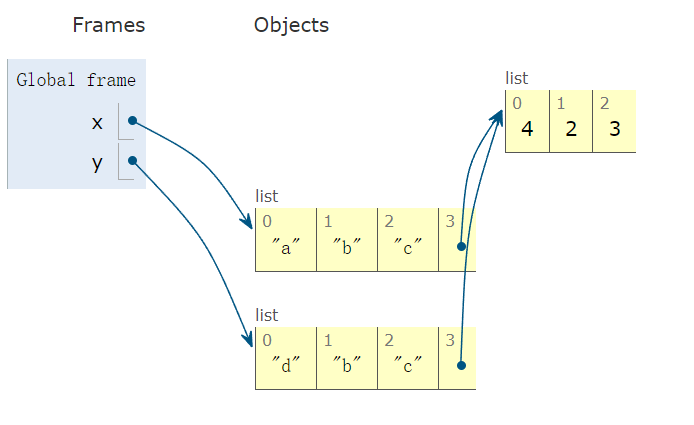
所以,copy 实现的是浅拷贝,只拷贝列表的第一层,嵌套的列表则不会拷贝。
2.2.2 深拷贝 deepcopy()
使用深拷贝需要导入库:
from copy import deepcopy
具体实现:
from copy import deepcopy
x = ['a', 'b', 'c', [1, 2, 3]]
y = deepcopy(x)
print(f'Original:\n\tx: {x}\n\ty: {y}\n\tid:\n\t\tid_x: {id(x)}\n\t\tid_y: {id(y)}\n\t\tid_children x[3]: {id(x[3])}\n\t\tid_children y[3]: {id(y[3])}') # id 用来获取变量的物理地址
y[0] = 'd'
print(f'After 1:\n\tx: {x}\n\ty: {y}\n\tid:\n\t\tid_x: {id(x)}\n\t\tid_y: {id(y)}\n\t\tid_children x[3]: {id(x[3])}\n\t\tid_children y[3]: {id(y[3])}')
y[3][0] = 4
print(f'After 2:\n\tx: {x}\n\ty: {y}\n\tid:\n\t\tid_x: {id(x)}\n\t\tid_y: {id(y)}\n\t\tid_children x[3]: {id(x[3])}\n\t\tid_children y[3]: {id(y[3])}')
# output
Original:
x: ['a', 'b', 'c', [1, 2, 3]]
y: ['a', 'b', 'c', [1, 2, 3]]
id:
id_x: 1916271245184
id_y: 1916271245312
id_children x[3]: 1916271878784
id_children y[3]: 1916271865600
After 1:
x: ['a', 'b', 'c', [1, 2, 3]]
y: ['d', 'b', 'c', [1, 2, 3]]
id:
id_x: 1916271245184
id_y: 1916271245312
id_children x[3]: 1916271878784
id_children y[3]: 1916271865600
After 2:
x: ['a', 'b', 'c', [1, 2, 3]]
y: ['d', 'b', 'c', [4, 2, 3]]
id:
id_x: 1916271245184
id_y: 1916271245312
id_children x[3]: 1916271878784
id_children y[3]: 1916271865600
2.2.3 一个特例
我们上面说了列表的深浅拷贝,但是浅拷贝的时候,虽然子列表没有完全 copy 出来,但是有一种情况下是不会互相影响。
思考一下🤔:也就是说,在浅拷贝的代码中,什么情况下修改子列表不会互相影响。
一个特例
x = ['毒药', '感冒药', '解药', ['香蕉', '瓜子', '八宝粥']]
y = x.copy()
print(f'Original:\n\tx: {x}\n\ty: {y}\n\tid:\n\t\tid_x: {id(x)}\n\t\tid_y: {id(y)}\n\t\tid_children x[3]: {id(x[3])}\n\t\tid_children y[3]: {id(y[3])}') # id 用来获取变量的物理地址
y[0] = '消炎药'
print(f'After 1:\n\tx: {x}\n\ty: {y}\n\tid:\n\t\tid_x: {id(x)}\n\t\tid_y: {id(y)}\n\t\tid_children x[3]: {id(x[3])}\n\t\tid_children y[3]: {id(y[3])}')
y[3] = '苹果'
print(f'After 2:\n\tx: {x}\n\ty: {y}\n\tid:\n\t\tid_x: {id(x)}\n\t\tid_y: {id(y)}\n\t\tid_children x[3]: {id(x[3])}\n\t\tid_children y[3]: {id(y[3])}')
# output
Original:
x: ['毒药', '感冒药', '解药', ['香蕉', '瓜子', '八宝粥']]
y: ['毒药', '感冒药', '解药', ['香蕉', '瓜子', '八宝粥']]
id:
id_x: 2259873051264
id_y: 2259873332480
id_children x[3]: 2259873051008
id_children y[3]: 2259873051008
After 1:
x: ['毒药', '感冒药', '解药', ['香蕉', '瓜子', '八宝粥']]
y: ['消炎药', '感冒药', '解药', ['香蕉', '瓜子', '八宝粥']]
id:
id_x: 2259873051264
id_y: 2259873332480
id_children x[3]: 2259873051008
id_children y[3]: 2259873051008
After 2:
x: ['毒药', '感冒药', '解药', ['香蕉', '瓜子', '八宝粥']]
y: ['消炎药', '感冒药', '解药', '苹果']
id:
id_x: 2259873051264
id_y: 2259873332480
id_children x[3]: 2259873051008
id_children y[3]: 2259873384080
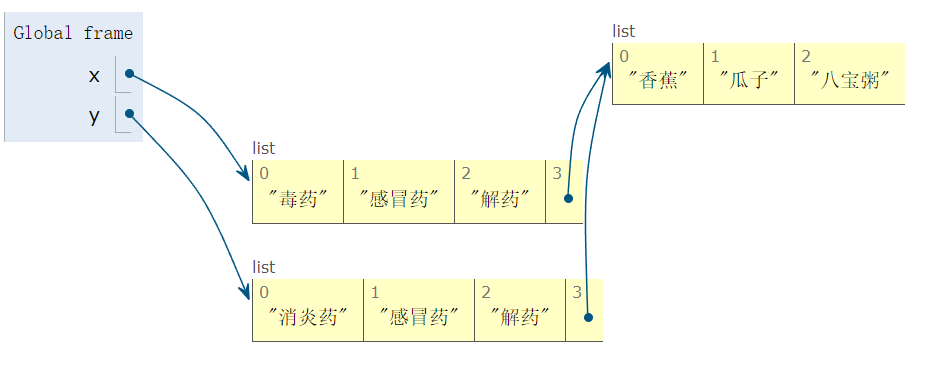
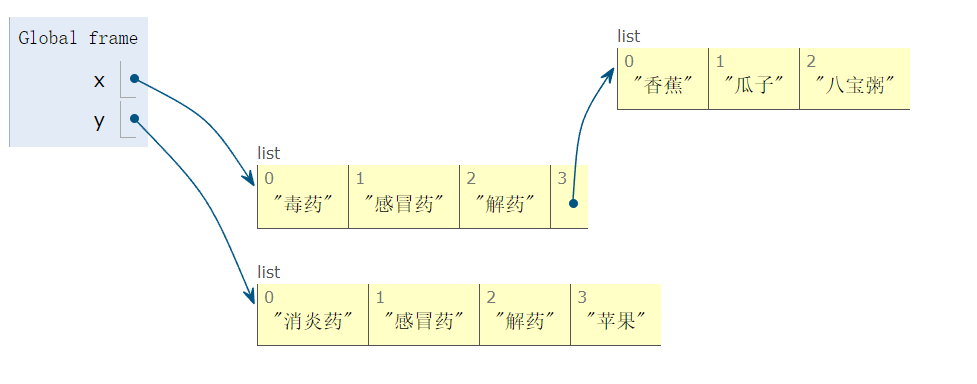
2.3 练习
2.3.1 列表元素去重
给定一个包含重复元素的列表,创建一个新列表,其中包含原列表的每个元素,但去除重复项。
::: tips
set(), list(), 可以一起使用!
:::
答案
numbers = [1, 2, 2, 3, 4, 4, 5]
numbers1 = list(set(numbers))
print(numbers1)
# output
[1, 2, 3, 4, 5]
2.3.2查找丢失的数字
- 获取用户输入,其中用户输入特定列表。此列表由连续的数字元素组成。但是,缺少一个数字。请编写一个程序,在不使用任何内置函数的情况下查找丢失的数字。
示例一:
Enter the list of numbers:1,2,3,4,6,7,8
The missing number is 5.
示例二:
Enter the list of numbers:1.2,4,5,6,7,8
The missing number is 3.
::: tips
使用 map()
大致用途:
list(map(加工,[鸡肉,玉米,猪肉,土豆])) 》》》[烤鸡,爆米花, 猪扒,薯条]
使用方法:
numbers = [1, 2, 3, 4, 5]
def doubler(n):
return n*2
result = map(doubler, numbers)
print(result)
print(list(result))
# output
<map object at 0x0000024BE03F01F0>
[2, 4, 6, 8, 10]
所以结合本题:
string_numbers = ['1', '2', '3', '99', '101', '131']
int_numbers = list(map(int, string_numbers))
print(int_numbers)
# output
[1, 2, 3, 99, 101, 131]
:::
答案:
string_numbers = input("Enter the list of the numbers")
string_numbers = string_numbers.replace(' ','') # 把用户输入的空格全部删除
list_numbers = string_numbers.split(',') # 以','分割字符串,返回列表
list_numbers = list(map(int, list_numbers)) # 利用 map 函数将列表中的 str 元素转为 int 元素
n = len(list_numbers) + 1 # 缺少一个数字,所以加一
sum_numbers = sum(list_numbers) # 实际总和
missing = int(n*(n+1)/2) - sum_numbers # 从 1 开始到用户输入列表的长度为不缺少数字的总和,减去实际总和就是缺少的数字
print(missing)
2.3.3 列表到字符串的转换
- 获取用户输入列表和特定的分隔符,并使用指定的分隔符将用户输入列表中的项目连接到字符串中。
示例一:
Please enter a list of elements, separated by commas: apple, banana, orange
Please enter the delimiter you wish to use: ;
apple; banana; orange
示例二:
Please enter a list of elements, separated by commas: Monday, Tuesday, Wednesday
Please enter the delimiter you wish use: ,
Monday,Tuesday,Wednesday
示例三:
Please enter a list of elements, separated by commas: dog, cat, mouse
Please enter the delimiter you wish to use: -
dog - cat - mouse
::: tips
- 此处也可以用到 map()
- join 在列表中也可以使用
:::
答案:
str_numbers = input("Please enter a list of elements, separated by commas: ")
delimiter = input("Please enter the delimiter you wish to use: ")
list_nubmers = str_numbers.split(',') # 将用户输入的字符串转为列表
list_nubmers = delimiter.join(list_nubmers) # 利用 join 函数改变列表元素间的间隔
print(list_nubmers)
2.3.4 列表对称性检查
- 检查列表是否对称(前后相同)
示例一:
Enter a list of items separated by commas:1,2,3,2,3
Is the entered list symmetric: False
示例二:
Enter a list of items separated by commas:1,2,3,2,1
Is the entered list symetric: True
答案:
Str = input('Enter a list of items separated yb commas: ')
List = list(Str.replace(' ','').split(','))
List_inv = List[::-1]
print(List)
print(List_inv)
print("Is the entered list symmetric: {}".format(List == List_inv))
Str = input('Enter a list of items separated yb commas: ')
List = list(Str.replace(' ','').split(','))
List_original = List.copy() # 复制原先的列表用于保存,用到了该小节的知识————深浅拷贝
List.reverse() # 原先的列表翻转了
print(List)
print(List_original)
print("Is the entered list symmetric: {}".format(List == List_original))
 0
0 0
0 0
0 0
0 0
0 0
0






